KAYLA: Ooph, itãs a scorcher!I wish I was on holiday.
ADA: Holiday: an extended period of leisureãÎãÎ like power saving mode for humans.
KAYLA: ErãÎ sort of.Hey, I know. Itãs the perfect time to build our virtual city swimming pool.
ZACH: Swimming pool! Ah yes!
KAYDA Ada, what do we need to do first?
ADA: To construct a swimming pool, itãs necessary to build a cuboid shaped hole in the ground.You will need to calculate the volume and the capacity.
KAYLA: Okay, letãs do it.So ermãÎ a cuboid shape?Whatãs that?
ADA: A cube is a three dimensional shape of equal height, width and depth.In a cuboid shape, the height, width and depth can be different.
ZACH: So, we need to select the size of cuboid shape we want our swimming pool to be.
ADA: Exactly, Zach.
ZACH: Hmm, so that simple cube is one centimetre on every side.
KAYLA: That means itãs one centimetre cubed.
ADA: Yes, thatãs right.the volume of the shape is 1cmô°.Volume means the amount of space an object takes up.
KAYLA: So, letãs line up these cubes to make the shape of our swimming pool.
ZACH: Ah, it looks great!But how do we work out the volume?
ADA: The formula for the volume of a cuboid is length x width x height.
KAYLA: Thanks, Ada.Okay, so the length is seven cubes.
ZACH: The width is five cubes and the height is three cubes.
ADA: You can do it step-by-step.Firstly, what is 7 x 5?
ZACH: I know my times tables.Itãs 35.
ADA: Correct.And next, you have to multiply 35 by 3.
KAYLA: Which makes 105.The volume is 105cmô°.
ZACH: I think our design is good to go.Letãs build it!
KAYLA: Huh! Hang on sec, itãs really small.Oops!We did that first cube in centimetres.Itãs one centimetre cubed.We used the wrong unit of measurement.
ZACH: So, what do we need to change it to?Kilometres? Metres?
KAYLA: HmmãÎOne kilometre is a thousand metres.Our city is about five kilometres wide, so a seven kilometre long pool would be way too big.
ZACH: And millimetres will make the pool too tiny, even for those little ladybirds.So, we need to change the measurement to metres. Right?
ADA: That is correct.
KAYLA: Okay, here goes.Centimetres to metres.
ZACH: Thatãs more like it!105 metres cubed.So, how much water do we need to fill it with?
ADA: The amount of liquid a container can hold is called itsã capacity.We measure capacity in litres.
KAYLA: So, we need to work out how many litres will fit into the pool.
ZACH: So, how many litres are in one metre cubed?
ADA: There are 1000 litres in a cubic metre.
KAYLA: And our pool is 105 metres cubed.
ZACH: So, 105 x 1000ãÎ
KAYLA: = 105,000 litres.That is a lot of water.
ZACH: Fill her up!
KAYLA: Perfect fit!The pool is filled to the brim.
ADA: Cannonball![PLOP]
ZACH: Oops!That pool is so full that there isnãt capacity for Ada and all the water.
KAYLA: Itãs like getting in a bath thatãs too full.Weãd better take some water out.
ADA: Now, thatãs what I call power saving.Holidays are fun.
On a hot day, Kayla and Zach decide to build a swimming pool for their virtual city.
Ada explains that their swimming pool will need to be a cuboid shape, and that they will need to work out its volume and its capacity.
Kayla asks Ada to recap what a cuboid is, and then they use cubic centimetres to build the shape of the swimming pool that they want. Ada explains that the volume of the shape means the amount of space it takes up, and that the volume of a cuboid can be calculated by multiplying the length by the width by the height.
Ada talks Zach through working out this calculation in steps. Once they are happy with their design, Zach and Kayla ãbuild itã, but it is tiny!
They realise they were using cubic centimetres when they should have been using cubic metres, and they rebuild the pool. They then discuss how much water they will need to fill the pool.
Ada teaches the children the term capacity, and explains that it is measured in litres. Ada explains that there are 1000 litres in a cubic metre.
Download/print an A4 activity sheet for this episode (PDF, 275KB). See link below for answers.
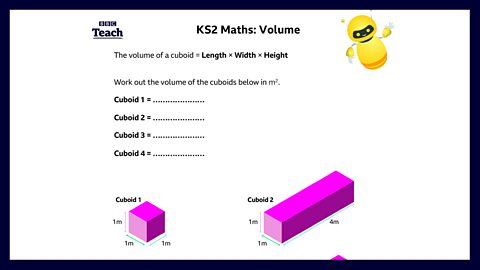
The children work out how much water they will need by multiplying the volume of the swimming pool by 1000. Thatãs a lot of water!
This short animated film is from the ôÕÑ¿å¥éá Teach series, Neon City: Measurement and Geometry.
Teacher notes
Before watching
You may wish to use this film to introduce the concept of volume to pupils. Alternatively, you could introduce the topic with practical opportunities to measure the volume of a shape, before moving on to watching the film to consolidate their learning.
During the film
You may want to stop the film at various points to check for understanding and provide further explanation. You could give the pupils cubes and ask them to build a model of their own ideal swimming pool, and ask them to work out the volume by counting the number of cubes they have used. When they have understood the concept of volume, move on to calculating the size of their cuboid using the formula length x width x height.
You could then ask them to use the model sentence provided by Zach and Kayla to explain their own calculations, for example:
- The volume of a cuboid equals the length times the width times the height. My calculation is ãÎcm x ãÎcm x ãÎcm which equals ãÎcmô°.
After watching
You could give the children practical opportunities to calculate the volume of 3D shapes, either using cubes or by measuring the length, width and height. Practise calculating the volume of different cuboids using the formula l x w x h.
You could also give the children opportunities to explore the capacity of different containers and to measure amounts of water using litres and millilitres. Explore how different containers can be different shapes but hold the same capacity. Make sure the children understand the difference between volume and capacity.
You might want to focus on reasoning and problem solving skills, for example:
- the volume of a cuboid is 24cmô°. How many different possible cuboids could you make?
(PDF, 690KB)
Curriculum notes
This short film is suitable for teaching maths at KS2 in England and Northern Ireland, 2nd Level in Scotland and Progression steps 2 and 3 in Wales.
More from Neon City: Measurement and Geometry
Measuring area. video
Ada introduces Zach and Kayla to the concept of area, and different ways to measure and calculate the area of rectangles, triangles and composite shapes.

Perimeter. video
Zach and Kayla are creating windows for their virtual house design and Ada explains how they can work out the perimeter for the windows they want.
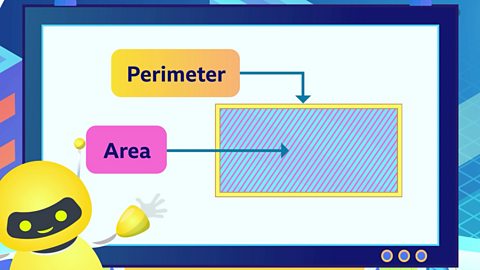
Metric and imperial measurements. video
Kayla and Zach decide to build a new hovertrain system from the city to the beach, but they get confused between kilometres and miles. Ada explains how to calculate betwen the two measurement systems, metric and imperial.

Measuring angles - Part 1. video
Kayla and Zach are designing ramps for the skatepark and Ada explains that designing ramps requires us to measure angles ã the amount of turn between two lines.
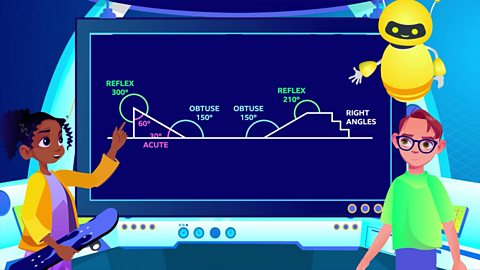
Measuring angles - Part 2. video
Whilst adding ramps to their virtual skatepark, Zach and Kayla progress from measuring angles to calculating angles on a straight line and full turn.

Missing lengths and angles. video
A computer virus has corrupted the Neon City software. Zach and Kayla must answer four questions within three minutes, or their city will be erased.

Regular and irregular polygons. video
Zachãs design for a pond in the virtual city park leads to Ada explaining the properties of regular and irregular polygons.
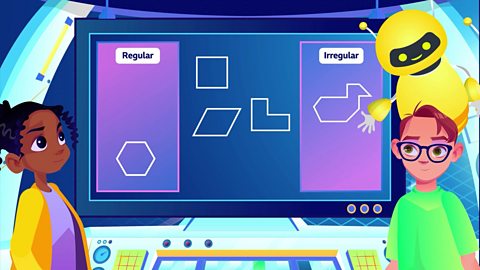
Coordinates on a grid. video
Kayla and Zach are designing a fairground and need to plot where to place the different rides, so Ada teaches them about the x-axis and y-axis on a coordinate grid.
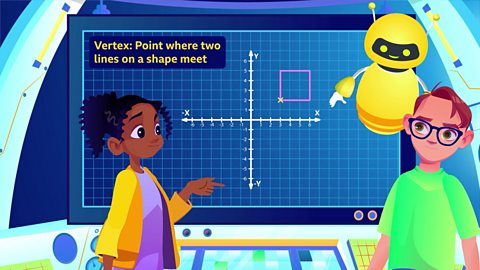
Units of time. video
Ada asks Kayla and Zach a series of quiz questions, requiring them to convert from one time measurement unit to another.
